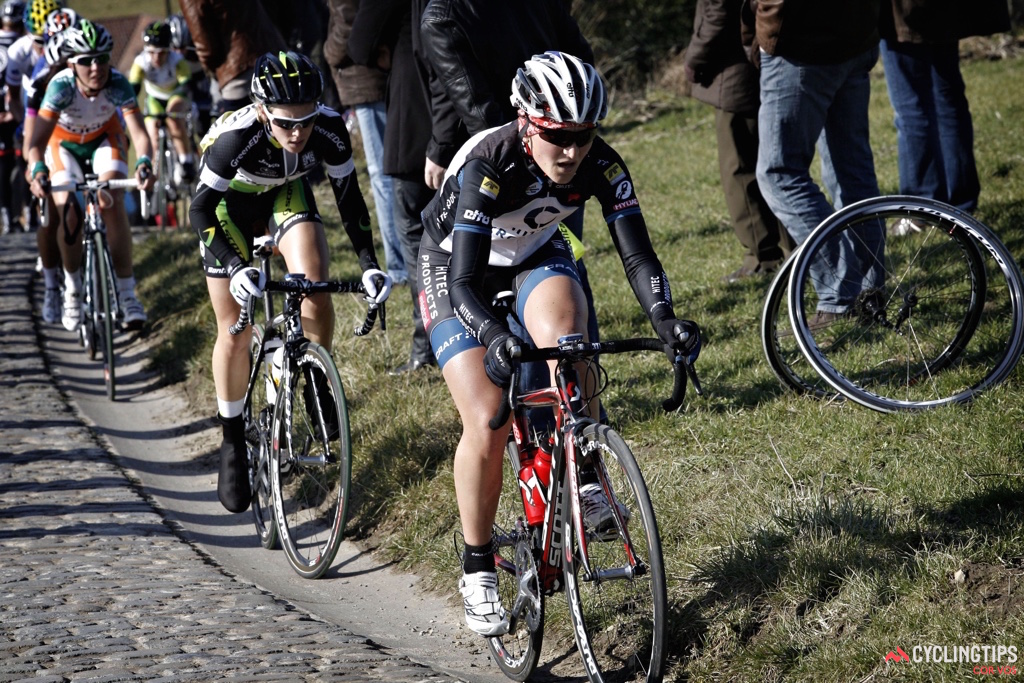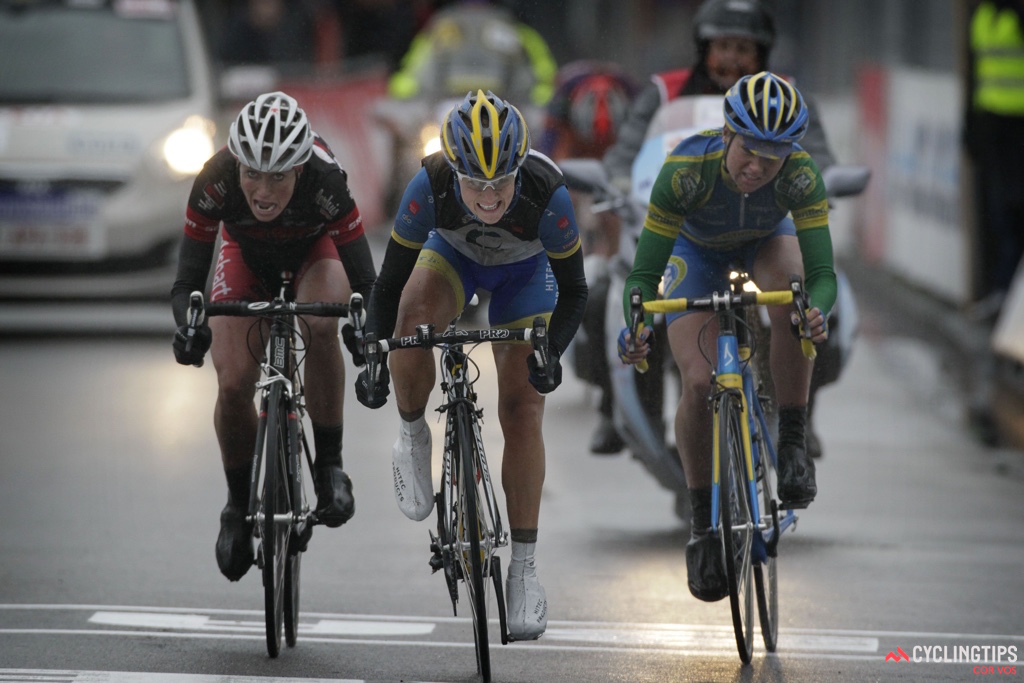Omloop het Nieuwsblad marks the start of the women’s road season in Europe. The Australian summer of racing followed by the Tour of Qatar provided a glimpse of what we might expect to see over the cobbles and climbs of Flanders.
The race on Saturday is the first of the spring classics, a series of mostly one-day races in Belgium and Holland. These races typically take place on historic courses that have been used for decades. The spring classics are well-known for bad weather and tough road conditions that combine to make some of the most challenging races of the season.
Omloop het Nieuwsblad, like several of the early spring races, plays hosts to a men’s race and a women’s race on the same day (February 28th this year). The two events share only the final 40 kilometres.
Ella CyclingTips spoke with two previous Omloop Het Nieuwsblad winners – Emma Johansson (2011, 2010) and Tiffany Cromwell (2013) – about the start of the European season.
In the last seven years, Emma Johansson (Oria-AIS) has won Het Nieuwblasd twice and podiumed an additional three times, including in 2013 when her then-teammate Tiffany Cromwell (Velocio-SRAM) took the win.
Cromwell is the first Australian to win the Belgian race. Her consistency in the spring has shown these races suit her strengths.
The course
The race can be broken up into three distinct sections. Nerves and numbers dictate the early action upon departure in Ghent, and most teams are perfectly happy if they can stay out of trouble ahead of the first few climbs.
Racing begins in earnest when the peloton hits the Côte de Trieu at 58.7 km. The Paterberg soon follows. And from there the climbs come in quick succession followed immediately by the cobbles.
By the time the women hit the run-in to the finish through Ghent, the selection is likely to have been made and the bunch behind will have been decimated.
Looking for more specifics on the course? Check out this route description from Velofocus.

Emma Johansson says:
The team did a recon this year even though the course is almost identical to last year. They were working on the Kluisberg last year, so we didn’t ride it. It will be the first real hill this year. The race will really start at the Côte de Trieu. The Paterberg is a climb with cobbles and after that it’s one hill after another until the finish.
It’s a really hard course. It feels like there is not time at all between the sections, and it’s quite hectic. The climbs start at the Kruisberg until more or less 20 kilometres from the finish, and the sections are coming so close to each other that you don’t have time to breathe.
There are so many things that can happen on this course. You need to be prepared for everything. You can’t lose your head. It might as well be over before you know it if you don’t pay attention. That’s what I like about it as well.
Tiffany Cromwell says:
When it comes to racing in Belgium, it’s all about knowing the roads and knowing the approach to each of the sectors. There are certain points that make or break your race every single year. It’s different than Holland where the flat roads mean the wind is a big factor. Here it’s all about the cobbles. It’s all about the climbs. It’s about being smart with the way you use your energy.
Historically, nothing happens until we hit the Côte de Trieu. That’s the first point in the race where we really have to be alert, and it’s an absolute race to the corner before the sector. If you don’t know how to approach that corner correctly, you’ve already lost.
Take for example the Paterberg. There’s a small gutter on the left-hand side of the road, which a lot of people will take instead of climbing the cobbles. It’s easier in the gutter because it’s such a steep, cobbled climb. If you’re too far back or you have a bad wheel in front of you – if the wheel in front of you loses their traction, unclips or they’re just slow – that can be it. Race gone. That’s where the three went last year. I was just off the wheel coming off the Paterberg, and they got over the top and kept going. We never saw them again.
The weather
Belgium in the spring is notorious for producing foul weather conditions that are embraced by many of the northern Europeans and merely tolerated by those less acclimated to the cold, wet and wind. We saw riders take to social media to post pictures of their mud-splattered faces following their recon rides. Current weather forecasts suggest a cold but dry day on Saturday.
Hum. Love Belgium. Omloop Het Nieusblad recon today! #Soaked #Frozen #Cobbles #Dirt pic.twitter.com/XUgorle2LE
— Valentina Scandolara (@ValeScandolara) February 25, 2015
Emma Johansson says:
I’m Scandinavian, so I’m used to the bad weather. They give good weather for Saturday, but it’s still going to be cold. It’s not going to be raining, at least that’s what they say at the moment, but there will be wind.
I think the start is probably going to be headwind, maybe head-cross. It could be that someone tries to put the race in the gutter early, but I don’t know if it’s going to be enough wind.
It looks like the wind will increase during the day, so that means when we turn and head back to Ghent, we’ll probably have a proper tailwind. With the tailwind home, it’s going to be a fast day of racing.
Tiffany Cromwell says:
I actually don’t think the wind is one of the biggest factors in Belgium unless it’s realy, really windy. There are some open sections of road but not many, so it’s not what makes the race. Qatar is all about the wind. Holland is all about the wind. Belgium is about the cobbles and the climbs.
We change direction on the course so many times anyway. The wind direction is always changing. One second you have a headwind and the next second it’s cross. It’s a tail next. It’s hard to use the wind to your advantage.
The Contenders
We would be hard-pressed to look past Emma Johansson or Lizzie Armitstead (Boels-Dolmans). Johansson has proven the most consistent on this course and Armitstead’s overall victory plus two stages win at the Ladies Tour of Qatar signalled her early season intentions. Tiffany Cromwell has declared Strade Bianche a target. The Italian race is next weekend, so the Australian must be coming into top form.
Beyond these three, a handful of the Dutch riders will be ones to watch. Defending champion Amy Pieters (Liv-Plantur), Annemiek van Vleuten (Bigla) and Anna van der Breggen (Rabo-Liv) could shine on Saturday.

Emma Johansson says:
We all saw in Qatar that Boels is super strong. I think they are coming into the season quite confidentially, especially after how well they performed in Qatar. That was some weeks ago and things can change. It’s totally different riding on cobbles and hills and with dirty conditions but normally Lizzie is always good in the beginning of the year and Ellen [van Dijk] is always strong on this type of course and in this weather. They have Chantal Blaak, too. They are definitely the team to watch.
I’m happy to be back in Belgium, and I consider this officially racing time. Qatar was just a warm-up. I’m ready for this.
Tiffany Cromwell says:
Emma is always good here. She loves this kind of racing. She has to be on everyone’s list. I’ve been training with Lizzie in Monaco. She started the season well, and she hasn’t lost any form. She will be good on Saturday, too. Aside from me and Emma, it’s been only Dutch winners here. This is their kind of racing. Wiggle will be motivated as well. Jolien d’Hoore is coming straight off the track. We don’t know if she has the road legs, but she’ll definitely have the speed.
Personally? I’m excited for it. I’m quietly confident. I’m not feeling especially super but I’m in a really good headspace. I’ve been training really well recently. I haven’t felt good on my bike for a long time, and I’m finally getting those feelings back. I’m not going to put it out there that I’m upski, but I think our team as a whole could have a good race. I think we could get up there for the win.
Additional Omloop het Nieuwsblad resources:

